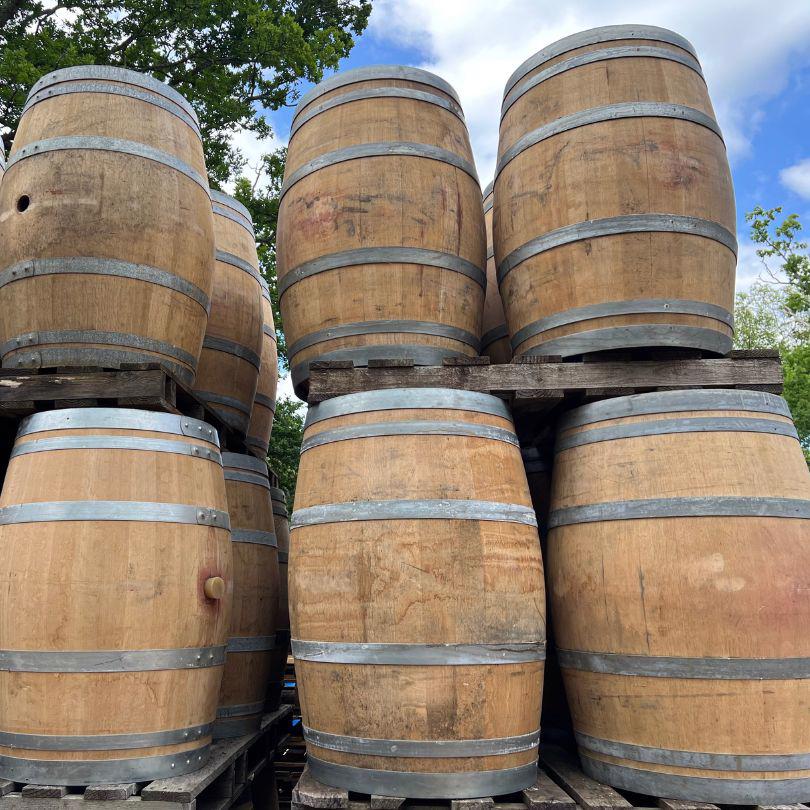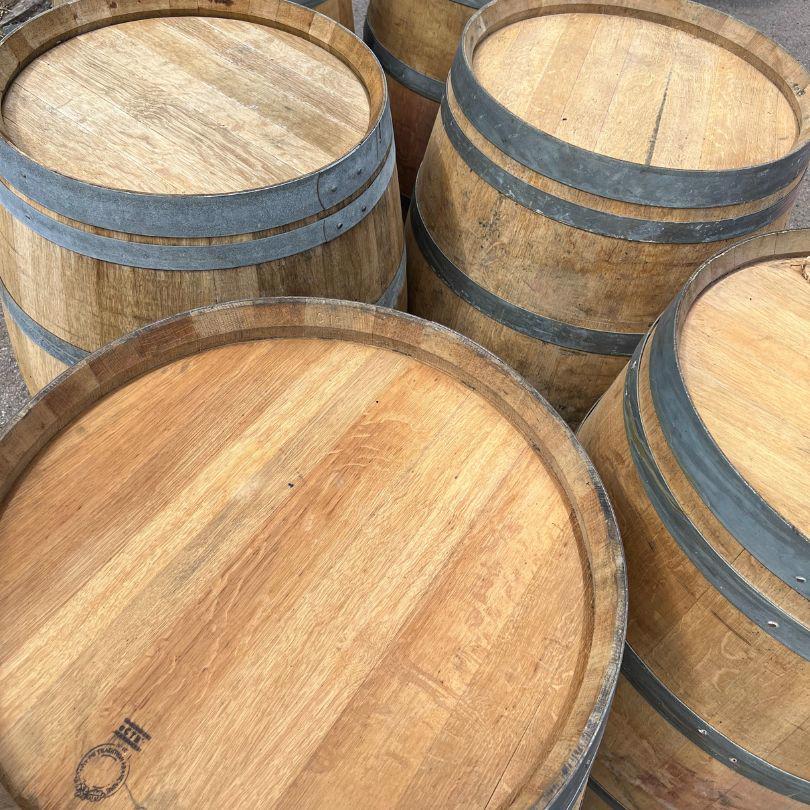Grade A Oak Wine Barrel
- Genuine Oak Wine Barrel
- Finishes, dimensions & colours vary
- 275 litres approx
- Mid-Diameter - 68cm
- Top diameter - 56cm
- Height - 94cm
Oak wine barrels make excellent decorative additions to the garden and terrace as a stand-up table or pot stand. They are also available as converted water butts.
Oak wine barrels make excellent decorative additions to the garden and terrace as a stand-up table or pot stand. They are also available as converted water butts. Finishes, colours and sizing may vary slightly as these are produced from natural materials. They feature a variety of finishing touches, all are based around a core design that include standard, hand curved staves and metal bands, but finishing specifications do differ and some may be daubed with paint around the bilge. Note that whiskey barrels are made to hold moisture; whilst empty, especially in drier weather, the wood may temporarily shrink. As such, some bands may become loose. Once the barrel has been filled with soil, the timber will expand and the bands will remain tight again. If the bands are loose they only require being tapped back into place.
Our oak wine barrels are crafted from slow-grown, dense hardwood – renowned for its strength, durability, and striking grain. Originally used in the ageing of wine, each barrel carries a unique story, now ready to be repurposed as a characterful garden planter, rustic water butt, or distinctive decorative feature.
The staves vary in colour from pale blonde to rich honey brown, offering a warm, natural look that blends effortlessly into traditional or contemporary outdoor settings.
Over time, the oak will naturally develop surface splits, shakes and minor cracks. These are cosmetic and part of the material’s natural behaviour outdoors – often opening and closing with the seasons – and only add to the aged charm of each barrel.
Reclaimed oak wine barrels are designed to be durable, but like all natural materials used outdoors, a little maintenance will help them last longer and look their best.
General Maintenance
- Positioning: Place barrels on a firm, level surface to avoid uneven pressure or moisture build-up at the base.
- Ventilation: Ensure air can circulate around the base to reduce the risk of rot, especially if the barrel is in direct contact with soil or damp ground.
- Seasonal Checks: Inspect your barrel periodically for signs of movement, drying, or weathering – especially after hot summers or heavy rains.
Cracks & Movement
- Natural Splitting: Surface cracks and small gaps between the staves are normal – they’re part of how oak naturally expands and contracts with moisture and temperature changes. These do not affect structural integrity.
- Tightening Hoops: If the metal hoops become loose over time, gently tapping them down can help keep the barrel staves in place. Avoid hammering directly onto the metal – use a block of wood to protect the surface.
As a Planter
- Drainage: Drill a few drainage holes in the base if not already present, and consider adding a layer of gravel before compost to prevent waterlogging.
- Liners: Using a breathable liner can help prolong the life of the wood by reducing direct contact with wet soil.
As a Water Butt
- Sealing: If the barrel has dried out and is leaking, filling it with water, and allowing it to swell for a few days will usually reseal the joints. This is a natural feature of traditional cooperage.
- Positioning: Raise the barrel slightly off the ground and use a secure lid or mesh to keep debris and mosquitoes out.
Appearance & Finish
- Preserving the Look: If you wish to keep the oak looking fresher or slow down the silvering effect from UV exposure, a breathable outdoor wood oil or UV-protective finish can be applied. Be sure to choose a product suitable for oak.
- Aged Patina: Many people prefer to let the barrel weather naturally to a silvery-grey – this requires no treatment and suits any garden style.
Oak wine barrels make excellent decorative additions to the garden and terrace as a stand-up table or pot stand. They are also available as converted water butts. Finishes, colours and sizing may vary slightly as these are produced from natural materials. They feature a variety of finishing touches, all are based around a core design that include standard, hand curved staves and metal bands, but finishing specifications do differ and some may be daubed with paint around the bilge. Note that whiskey barrels are made to hold moisture; whilst empty, especially in drier weather, the wood may temporarily shrink. As such, some bands may become loose. Once the barrel has been filled with soil, the timber will expand and the bands will remain tight again. If the bands are loose they only require being tapped back into place.
Our oak wine barrels are crafted from slow-grown, dense hardwood – renowned for its strength, durability, and striking grain. Originally used in the ageing of wine, each barrel carries a unique story, now ready to be repurposed as a characterful garden planter, rustic water butt, or distinctive decorative feature.
The staves vary in colour from pale blonde to rich honey brown, offering a warm, natural look that blends effortlessly into traditional or contemporary outdoor settings.
Over time, the oak will naturally develop surface splits, shakes and minor cracks. These are cosmetic and part of the material’s natural behaviour outdoors – often opening and closing with the seasons – and only add to the aged charm of each barrel.
Reclaimed oak wine barrels are designed to be durable, but like all natural materials used outdoors, a little maintenance will help them last longer and look their best.
General Maintenance
- Positioning: Place barrels on a firm, level surface to avoid uneven pressure or moisture build-up at the base.
- Ventilation: Ensure air can circulate around the base to reduce the risk of rot, especially if the barrel is in direct contact with soil or damp ground.
- Seasonal Checks: Inspect your barrel periodically for signs of movement, drying, or weathering – especially after hot summers or heavy rains.
Cracks & Movement
- Natural Splitting: Surface cracks and small gaps between the staves are normal – they’re part of how oak naturally expands and contracts with moisture and temperature changes. These do not affect structural integrity.
- Tightening Hoops: If the metal hoops become loose over time, gently tapping them down can help keep the barrel staves in place. Avoid hammering directly onto the metal – use a block of wood to protect the surface.
As a Planter
- Drainage: Drill a few drainage holes in the base if not already present, and consider adding a layer of gravel before compost to prevent waterlogging.
- Liners: Using a breathable liner can help prolong the life of the wood by reducing direct contact with wet soil.
As a Water Butt
- Sealing: If the barrel has dried out and is leaking, filling it with water, and allowing it to swell for a few days will usually reseal the joints. This is a natural feature of traditional cooperage.
- Positioning: Raise the barrel slightly off the ground and use a secure lid or mesh to keep debris and mosquitoes out.
Appearance & Finish
- Preserving the Look: If you wish to keep the oak looking fresher or slow down the silvering effect from UV exposure, a breathable outdoor wood oil or UV-protective finish can be applied. Be sure to choose a product suitable for oak.
- Aged Patina: Many people prefer to let the barrel weather naturally to a silvery-grey – this requires no treatment and suits any garden style.
GET IN TOUCH
Looking for advice or would like a quote?
Fill out our quick form below and we’ll get back to you by the end of the next working day.


